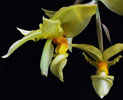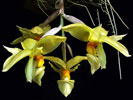|
|
|
|
 |
Email Address Recovery or Password Reset |
Use our Change Password page, and you can set a new password, or if you don't remember which email address you
registered with, the same page may be able to suggest it based on another you enter.
|
|
|
|
|
| |
Flasks of
Stanhopea graveolens 'Dunkel Gelb' × self |
|
| |
|
|
| |
| Number: |
TN3479 |
| Name: |
Stanhopea graveolens 'Dunkel Gelb' × self
|
| Type: |
self (What's that?) |
|
Seed Donor: |
Dale Borders
|
|
Click to Enlarge

Pod Parent Flowers |
Click to Enlarge

Pod Parent Inflorescence |
|
|
|
| |
Culture Notes from Donor: Parent plant: Temperature range I (60-83°F)
Comments: Parent plant: Flowers are pleasantly mint scented.
For additional origin/habitat information supplied courtesy of
Charles and Margaret Baker, see further below, near the bottom of this page.
|
Temperatures we attempt to use in the lab & greenhouse:
| For Species: |
|
Spring, Summer, Autumn, Winter: days average 74°F, nights 56°F; best fit is Cool-Intermediate 75-58°F
(Source:
Baker's Web OSC) |
|
About the name...
| Etymology of |
graveolens |
|
From Latin "graveolens" very fragrant.
(Source:
Mayr & Schmucker 1998) |
| Etymology of |
Stanhopea |
|
In honor of Philip Henry, 4th Earl of Stanhope, president of the London Medico-Botanical Society during the early part of the 19th century.
(Source:
Pridgeon 1992) |
| Pronunciation of |
graveolens |
|
gra-VEE-oh-lenz
(Source:
Hawkes 1978) |
| Pronunciation of |
Stanhopea |
|
stan-HOPE-ee-ah
(Source:
Pridgeon 1992) |
|
If you would like to direct someone to this web page, please copy and paste this URL into your email:
http://troymeyers.com/d?013479
| Flask Information |
| Availability: |
We have sold all of the flasks for this item. |
| You should: |
Consider getting individual plants or compots instead of a flask.
You can place a "Notify Flask Recipients" Request, and either we or a flask recipient may contact you when plants are available.
You may also place a "Notify Retries" Request, and if an identical pollination (the same parents) is done again, we'll let you know.
You may reserve a flask, but it's very unlikely you'll get one ...this could only happen if we found a flask that we didn't know we had. |
| Yield Estimate: |
357 plants (based on flask surveys done 06/23/2003 through 07/28/2004)
|
| Plantlet Sizes: |
From many flasks 30 - 120 mm plants (based on flask surveys done 03/16/2004 through 07/28/2004)
From one most recently surveyed flask 80 - 120 mm (07/28/2004)
|
|
You might also want to:
|
View the seed assay for this item.
View items of the same species.
View items of the same genus.
|
| Ordering Information |
| You are not currently logged in. |
|
You must be a registered user and be logged in to reserve a flask or place a notification request. Please log in:
|
|
 |
Email Address Recovery or Password Reset |
Use our Change Password page, and you can set a new password, or if you don't remember which email address you
registered with, the same page may be able to suggest it based on another you enter.
|
|
|
|
|
|
|
|
| |
The origin/habitat information below is supplied courtesy of Charles and Margaret Baker
The following information is based on the name of the plant provided by the donor, and assumes that the name is correct. If the plant has been misidentified, then the following information may not be correct.
This text is copyrighted by the Bakers and may not be reproduced without permission.
ORIGIN/HABITAT: Mexico southward to Honduras and El Salvador. In Belize,
plants grow near the Cayo (Mt. Pine Ridge Reserve) and Toledo Districts in
riverine forests. Earlier writers reported the occurrence of this species
in Panama, but Dressler in, "A Checklist of the Orchids of Panama as Known
Today", which was appended to the 1980 publication of, "Orchids of Panama"
by L. O. Williams and Paul H. Allen, reported that these plants were
actually S. costaricensis. Plants in El Salvador collected at Boquerón, in
the crater of the San Salvador volcano at 5900 ft. (1800 m) and in Cerro
Grande de Apaneca at 4900 ft. (1500 m) that were originally discussed as
S. wardii by Hamer (1964) were later reported by Hamer (1970) to actually
be S. graveolens. The plants discussed as S. wardii by Ames and Correll
(1952-1965), which were said to grow as epiphytes on trees and on rocks in
humid forests at elevations up to 8850 ft. (2700 m), should probably be
referred to as S. graveolens. Some reports include Brazil in the range of
distribution, but many current authorities suspect that those reports
probably refer to a different species.
More about this information and the Bakers...
|
|
|
| |
|
|
|